

Examples:
Paolo Veronese (Caliari) (Italian, c. 1528-1588)
Sofonisba Anguissola (or Anguisciola) (Italian, 1535/40-1625). See feminist art.
Paul Bril (Flemish, 1554-1626)

Annibale
Carracci (Italian, 1560-1609), The Virgin Appearing to St. Luke and St. Catherine,
1592, oil on canvas,
4.01 x 2.26 m, Louvre.

Caravaggio (Michelangelo Merisi) (Italian,
Lombard, 1571/73-1610), The Musicians, c. 1595, oil
on canvas, 36 1/4 x 46
5/8 inches (92.1 x 118.4 cm), Metropolitan Museum of Art, NY.
(On the Met's page, you can enlarge any detail.) See Caravaggisti.
Caravaggio (Michelangelo Merisi), The Crucifixion of St. Andrew, 1607, oil on canvas, 202.5 x 152.7 cm, Cleveland Museum of Art.
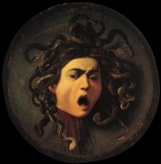
Caravaggio, Medusa, oil on a circular convex leather shield, diameter 55.5 cm, Uffizi Gallery, Florence. See mythology and snake.

Peter
Paul Rubens (Flemish, 1577-1640), The Alliance of Earth and Water (The River Scheldt
and Antwerp), c. 1618, oil
on canvas, 87 1/2 x 71
inches (222.5 x 180.5 cm), Hermitage Museum, St. Petersburg,
Russia. Also see Rubénisme.
Peter Paul Rubens, Isabella Brant, c. 1620, oil on wood, Cleveland Museum of Art.

Peter Paul Rubens, Bacchus, 1638/40, oil
on canvas (transferred
from panel), 75 x 63 1/2 inches (191 x 161.3 cm), Hermitage Museum,
St. Petersburg, Russia.

Frans
Hals (Dutch, c. 1581-1666), Young Man and Woman in an Inn ("Yonker Ramp
and His Sweetheart"), 1623, oil
on canvas, 41 1/2 x 31
1/4 inches (105.4 x 79.4 cm), Metropolitan Museum of Art, NY.
(On the Met's page, you can enlarge any detail.)
Bernardo Strozzi (Italian, 1581-1644)

Gerrit van Honthorst (Dutch, 1590-1656),
The Denial of St. Peter, about 1620-1625,
oil on canvas,
43 1/2 x 57 inches, Minneapolis Institute of Arts. Also see Caravaggisti and Dutch
art.
Simon Vouet (French, 1590-1649)

José
(Jusepe) de Ribera (Spanish, 1591-1652), The Club-Footed Boy, 1642, oil
on canvas, 1.64 x 0.93
m, Louvre.

José (Jusepe) de Ribera, The Holy Family with Saints Anne and Catherine
of Alexandria, 1648, oil
on canvas, 82 1/2 x 60
3/4 inches (209.6 x 154.3 cm), Metropolitan Museum of Art, NY.
(On the Met's page, you can enlarge any detail.)
Georges De La Tour (French, 1593-1652)
Artemisia Gentileschi (Italian, 1593-1652/53) See feminist art.

Jacob Jordaens (Flemish, 1593-1678), The Bean King, c. 1638, oil
on canvas (transferred
from old canvas), 62 x 83 inches (160 x 213 cm), Hermitage Museum,
St. Petersburg, Russia.

Louis
Le Nain (French, c. 1593-1648), The Dairymaid's Family, 1640s, oil
on canvas, 20 x 2e3 inches
(51 x 59 cm), Hermitage Museum, St. Petersburg, Russia.

Nicolas Poussin (French, 1593/94-1665), Parnassus, oil
on canvas, 145 x 197 cm,
Prado Museum, Madrid. Also see Neoclassicism and Poussinisme.

Nicolas
Poussin, The Death of Germanicus, 1627, oil
on canvas, 58 x 77 3/8
inches, Minneapolis Institute of Arts. See history painting.

Nicolas Poussin, The Abduction of the Sabine Women, probably
1633-34, oil on canvas,
60 7/8 x 82 5/8 inches (154.6 x 209.9 cm), Metropolitan Museum
of Art, NY. (On the Met's page, you can enlarge any detail.)

Nicolas
Poussin, Landscape with Polyphemus, oil
on canvas, 149 x 197.5
cm, Hermitage Museum, St. Petersburg, Russia.
Copy after Nicolas Poussin, Adoration of the Golden Calf, 16th - 17th century, oil on canvas, 38 x 52 inches (96.5 x 132 cm), Legion of Honor, San Francisco.
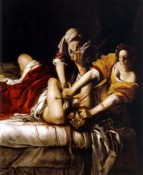
Artemisia Gentileschi (Italian, 1593-1651/53),
Judith
Beheading Holofernes, 1620, oil
on canvas, 78 3/8 x 64
inches (199 x 162.5 cm),
Uffizi, Florence. See Caravaggisti
and feminism and feminist art.
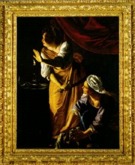
Artemisia Gentileschi (Italian, 1593-1651/53),
Judith and Her Maidservant with the Head of Holofernes,
c. 1625, oil on canvas,
1.8 x 1.4 m (72 1/2 x 55 3/4 inches, Detroit Institute of Art,
MI. See frame.

Georges de La Tour (French, 1593-1652), The Fortune Teller, probably 1630s, oil on canvas,
40 1/8 x 48 5/8 inches (101.9 x 123.5 cm), Metropolitan Museum
of Art, NY. (On the Met's page, you can enlarge any detail.)
See narrative
art.
![]()
Pietro
da Cortona (Italian, 1596-1669), Christ on the Cross with the Virgin Mary, Mary
Magdalene, and Saint John, about 1661, pen and brown
ink, with gray-brown wash, heightened
with white body color
over black chalk,
15 7/8 x 10 7/16 inches (40.3 x 26.5 cm), J. Paul Getty Museum,
Malibu, CA.
![]()
Gianlorenzo Bernini (Italian, 1598-1680),
Boy with a Dragon, Rome, 1614-1620, marble, 22 x
20 x 16 inches (55.7 x 52 x 41.5 cm), J. Paul Getty Museum, Malibu,
CA.
![]()
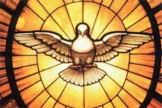
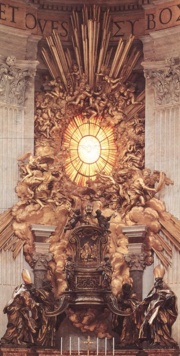
Gianlorenzo Bernini, Dove of the Holy Spirit, c. 1660.
This stained glass window is the highly dramatic
focal point of The Throne of Saint Peter, 1657-66, marble, white
and gilt stucco,
and stained glass, overall height
about 100 feet, Saint Peter's Basilica, Vatican, Rome.
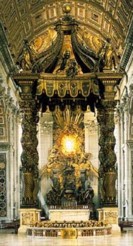
The Throne is a huge Baroque sculptural composition behind the altar, in the apse of the basilica.
The Throne of Saint Peter is first seen, when approaching it, as it is framed
by Bernini's Baldacchino, 1624-33.
See baldacchino.

Francisco de Zurbarán (Spanish, 1598-1664), The Young Virgin, c. 1632-33, oil
on canvas, 46 x 37 inches
(116.8 x 94 cm), Metropolitan Museum of Art, NY. (On the Met's
page, you can enlarge any detail.)

Diego
Velázquez (Diego Rodríguez de Silva y Velázquez)
(Spanish, 1599-1660), Juan de Pareja (c. 1610-1670), 1650,
oil on canvas,
32 x 27 1/2 inches (81.3 x 69.9 cm), Metropolitan Museum of Art,
NY. (On the Met's page, you can enlarge any detail.)

Diego Velázquez, The Luncheon (Three Men at a Table),
c. 1617/18, oil on canvas, 43 x 40 inches (108.5
x 102 cm), Hermitage Museum, St. Petersburg, Russia.

Diego
Velázquez, The
Family of Philip IV, or "The Maids of Honor (Las Meninas)", c. 1656, oil
on canvas, (318 x 276 cm),
Prado Museum, Madrid.
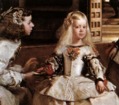 This
is a group portrait
of an exceptional sort:
This
is a group portrait
of an exceptional sort:
In the center-foreground
is the infanta (princess) attended by her meninas (maids of honor)
— companions
 including
two young ladies, a dwarf, a child, a dog, a nun, and a tutor.
including
two young ladies, a dwarf, a child, a dog, a nun, and a tutor.
This little party is visiting the studio
where Velázquez stands before his canvas. We see the back of it, perched upon
an
 easel.
The painter and most of the others look toward the king and queen
as they pose for the painting in progress.
easel.
The painter and most of the others look toward the king and queen
as they pose for the painting in progress.
The king and queen would not actually be
visible in this picture if their reflected
image could not be seen in a mirror
placed on the opposite wall. Altogether this is a view, which
could only be seen by the king and queen themselves, as
 they pose for their
portrait. The point of view
of every person who gazes
upon this painting is that of the king and queen of Spain. A
very privileged vantage indeed!
they pose for their
portrait. The point of view
of every person who gazes
upon this painting is that of the king and queen of Spain. A
very privileged vantage indeed!
Further
increasing the sense that we are present at a specific moment
is our glimpse of a man in the distant doorway, pausing as he
descends or ascends — either entering or exiting the chamber.
See after, Cubism, genre,
and Pop Art.
In the manner of Diego Velázquez, Dona Mariana of Austria, Queen of Spain, 1649, oil on canvas, 27 3/8 x 22 inches, Legion of Honor, San Francisco.

Claude Lorrain (Claude Gellée) (French,
1600/5?-1682), Pastoral Landscape, 1638, oil
on canvas, 38 1/4 x 51
1/4 inches, Minneapolis Institute of Arts. See landscape.
Claude Lorrain (Claude Gellée), View of Tivoli at Sunset, 1644, oil on canvas, 39 1/2 x 53 1/2 inches (100 x 136 cm), Fine Arts Museums of San Francisco, CA.

Claude
Lorrain (Claude Gellée), The Ford, possibly 1636, oil
on canvas, 29 1/4 x 39
3/4 inches (74.3 x 101 cm), Metropolitan Museum of Art, NY.

Claude Lorrain (Claude Gellée), Sunrise, possibly 1646-47, oil
on canvas, 40 1/2 x 52
3/4 inches (102.9 x 134 cm), Metropolitan Museum of Art, NY.

Claude
Lorrain (Claude Gellée), View of La Crescenza, 1648-50, oil
on canvas, 15 1/4 x 22
7/8 inches (38.7 x 58.1 cm), Metropolitan Museum of Art, NY.

Rembrandt Harmensz. van Rijn (Dutch, Amsterdam,
1606-1669), Flora, c. 1635, oil
on canvas, 49 x 40 inches
(125 x 101 cm), Hermitage Museum, St. Petersburg, Russia.
![]()
Rembrandt Harmensz. van Rijn, Nude Woman with a Snake, about 1637,
red chalk heightened
with white body color,
9 11/16 x 5 7/16 inches (24.7 x 13.7 cm), J. Paul Getty Museum,
Malibu, CA. See nude.

Rembrandt
Harmensz. van Rijn, Aristotle with a Bust of Homer, 1653,
oil on canvas,
56 1/2 x 53 3/4 inches (143.5 x 136.5 cm), Metropolitan Museum
of Art, NY. (On the Met's page, you can enlarge any detail.)

Rembrandt Harmensz. van Rijn, The Return of the Prodigal Son, c. 1668/69,
oil on canvas,
103 x 81 inches (262 x 205 cm), Hermitage Museum, St. Petersburg,
Russia.
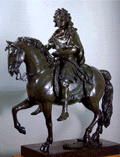
Francois
Girardon (French, 1628-1715), Model for the Equestrian Statue of Louis XIV,
bronze, Hermitage Museum, St. Petersburg,
Russia. See equestrian statue and model.

Jacob Isaacksz van Ruisdael, The Marsh, 1660s, oil
on canvas, 28 1/2 x 39
inches (72.5 x 99 cm), Hermitage Museum, St. Petersburg, Russia.

Jan (or
Johannes) Vermeer (Dutch, Delft, 1632-1675), Young Woman with a Water Jug, c. 1660-67,
oil on canvas,
18 x 16 inches (45.7 x 40.6 cm), Metropolitan Museum of Art,
NY. (On the Met's page, you can enlarge any detail.)

Jan (or Johannes) Vermeer, The Glass of Wine, c. 1661/62, Gemäldegalerie,
Berlin. See drapery.

André-Charles
Boulle (French, 1642-1732), Wardrobe (alternatively known as an Armoire), Paris, around 1700, made of
oak and pine, with ebony, tortoiseshell,
inlaid (marquetry)
with brass and tin
veneering, pewter,
horn, and gilded bronze
(ormolu), 102 x 58 x 25
inches (260 x 148 x 64 cm), Louvre. See furniture.

Giuseppe Mazzuoli (Italian, c.1644-1725),
The Death of Adonis, 1709, marble, height 193 cm, Hermitage Museum,
St. Petersburg, Russia.
![]()
Luisa
Roldán (Spanish, 1650-1704), sculptor; Luis Antonio de
los Arcos, polychromer, gilder, St. Ginés de la Jara, about 1692,
polychromed wood (pine and cedar) with glass
eyes, height 69 1/4 inches
(176 cm), J. Paul Getty Museum, Malibu, CA.
Jean Antoine Watteau (French, 1684-1721).

Giovanni Battista Tiepolo (Italian, 1696-1770),
Maecenas Presenting the Liberal Arts to Emperor
Augustus, c. 1745, oil
on canvas, 27 x 35 inches
(69.5 x 89 cm), Hermitage Museum, St. Petersburg, Russia.

Nicola Salvi (Italian, 1697-1751), Trevi Fountain (Fontana di Trevi) (see two much closer and larger views: at night and at day), 1629-1762, Rome. This is the largest, most ambitious, and most famous of the great Baroque fountains of Rome. The allegorical subject of this sculptural ensemble is the taming of the waters. Tumbling about, water and stonework appear as a lively stage set, turning the small square that surrounds it into something like a theater. The fountain is set against the back of the Palazzo Poli, which was given a new facade of Corinthian columns that link the two main stories, and flank a triumphant arch with a large niche representing the palace of Neptune. In the central niche is Neptune, the sea god, riding a winged chariot guided by tritons through the gushing waters. The chariot is drawn by winged horses, led by a pair of tritons. The Trevi Fountain sits at the end of the Aqua Vergine, one of the ancient aqueducts which supplied water to Rome. Now it supplies the fountain's water. Pope Clement XII commissioned Salvi to design the fountain in 1730. It was completed in 1762, and called the Trevi because its position at the intersection of three streets — tre vie. There is a frequently cited legend that if you throw a coin over your shoulder into the fountain, your return to Rome is guaranteed.
François Boucher (French, 1703-1770).
See Rococo.
In architecture, Francesco Borromini (Italian, 1599-1667) used curved surfaces to create a pattern of light and dark as well as a sense of movement on his church façades. Here's a link to images of Baroque architecture. Also, this term is used (with a small "b") to describe art of any period which is reminiscent of this style, exaggerated in some dramatic way, or having rich and sometimes bizarre ornamentation.
Also see Caravaggisti, Enlightenment, Rococo, seicento, settecento, and tenebroso or tenebrism.
https://inform.quest/_art
Copyright © 1996-![]()